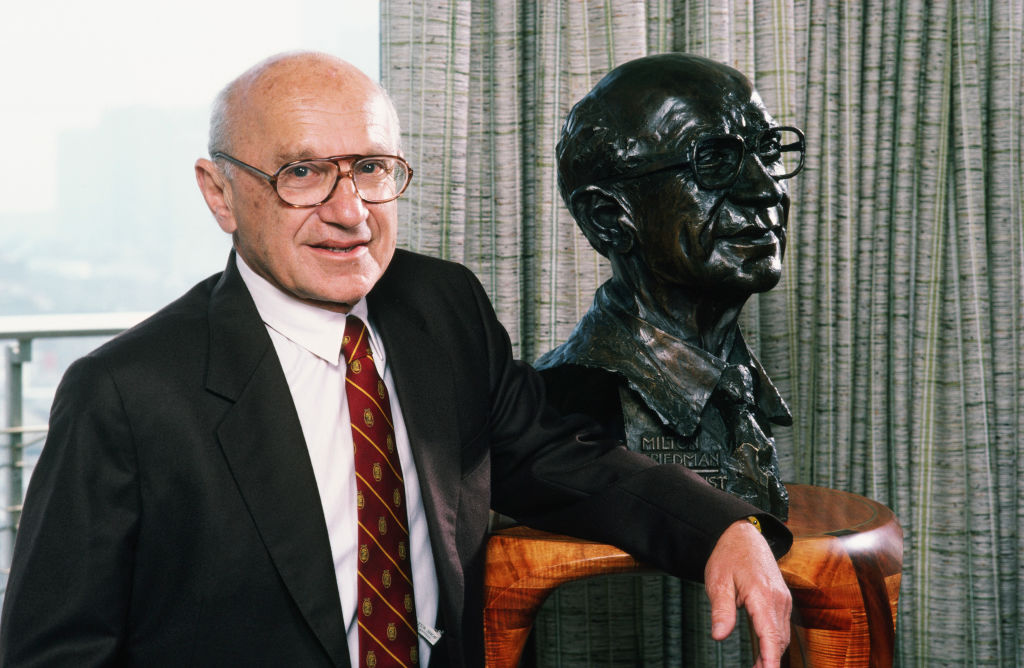Legendary economist Milton Friedman was one of the most influential academic minds of the 20th century. Be it Free to Choose or Capitalism and Freedom, his books and essays have swayed multiple generations to view capitalism, markets, and liberty as virtues, combating the sins of socialism and big government. Thanks to YouTube, millennials and Generation Z can watch his fascinating lectures and interviews and learn more about economics than they would by attending a Keynesian indoctrination session at one of today’s left-wing re-education centers. While millions worldwide continue to celebrate Friedman, others think that his philosophy should be buried or cremated because they have supposedly failed the United States and the rest of the world. Is that even remotely accurate?
Barron’s Delivers a Eulogy

Barron’s recently celebrated the 50th anniversary of Friedman’s famous New York Times essay, titled “A Friedman Doctrine.” Friedman wrote in the newspaper that used to allow individual thought: “There is one and only one social responsibility of business—to use its resources and engage in activities designed to increase its profit.” But Barron’s contributing author, Omidyar Network CEO Mike Kubzansky, was not holding a toast for this sublime idea. Instead, the writer proposed taking an ax to the free-market ideal.
“A lot has changed since 1970. Computers now have 8,000 times more storage. Floppy disks are now only useful as coasters. The Pinto literally went up in flames. But despite our many advances, some antiquated ideas continue to prevail. This includes Friedman’s economic philosophy, which we now know is as outdated and dangerous as the Pinto. So, on this, the 50th anniversary of its publication, the time has come to bury Friedman’s ideas once and for all.”
The piece asserted that concepts of small government, efficiency, and corresponding free markets have not succeeded. It alluded to lackluster dynamism, corporate buybacks, subpar economic growth, falling entrepreneurship rates, racial inequality, and economic insecurity.
“By almost every measure, Friedman’s version of capitalism has failed,” Kubzansky stated.
Barron’s provided a panacea that would reimagine capitalism and “rebalance the relationship between markets, government, and communities.” The solutions were unsurprisingly vague, serving as nostrums that appeal to the unwashed anti-capitalist masses: reforming corporate governance, limiting shareholder primacy, and building grassroots community voices. “When that is done, Milton Friedman’s failed ideas will finally rest in peace,” Kubzanksy concludes.
Are Kubzansky’s grievances justified? Is it time to bury Friedman’s ideas? Has capitalism failed America?
In Defense of Milton Friedman
Kubzansky thinks all of Friedman’s ideas have been made into law and inserted into the United States constitution. While the U.S. is generally a market-oriented economy, the system has been bastardized through repeated government intervention, cronyism, and the Federal Reserve. The government continues to expand in size and scope, the central bank distorts the marketplace, and the revolving door between Washington and Wall Street continues.
If you were to watch only one lecture or read a single essay, you would easily deduce that Friedman was a staunch critic of the state. Bureaucracy, endless interventions, regulations, and taxes – this is not Friedman’s version of capitalism. Despite articulating the role for the Fed in monetary policy, he tergiversated later in his career and called for the abolition of the central bank. It still stands today, artificially controlling interest rates and generating moral hazard. Contrary to popular opinion on CNN or MSNBC, the U.S. has not stewed in the juices of laissez-faire principles.

(Photo by George Rose/Getty Images)
That is not to say none of his ideas have been tried. One of the reasons the U.S. is the world’s largest and richest economy is because the nation has been mostly capitalistic – it is the barrage of Keynesian doctrine and leftist orthodoxy that have strangled the free-market system. That said, Friedman acknowledged that the greatest threat to the free-enterprise system is free enterprise. Why? Because big business can utilize the government to its advantage, advancing and imposing burdensome laws that hurt smaller companies and allow behemoths to survive and quasi-monopolize segments of the marketplace.
The fundamental objective of a free economy, as Friedman opined, is to give “people what they want” rather than being dictated to by a particular group to think what they should want. He noted that “underlying most arguments against the free market is a lack of belief in freedom itself.” A business becomes successful by satisfying demand. When you achieve this goal, you become profitable. Profit is an indicator that you have done something right. If the Amazons and Apples of the world are maximizing their bottom line, it is because they have sold something people wanted. It is not a nefarious scheme; it is a voluntary exchange.
Kubzansky argues that society needs to present “new ideas better attuned to the realities of this century,” from pandemics to structural racism. But markets have done a decent job of coming to our aid during a public health crisis and elevating impoverished minorities. At the time of this writing, there are more than 100 Coronavirus vaccines and treatments in development, and businesses are producing personal protective equipment at enormous speeds. Why? They are driven by profit.
If there is structural racism, then is that not a problem of government rather than an economic system?
Ultimately, today’s foundation, no matter how much it has been regulated and taxed to death, benefits everyone – black or white, man or woman, rich or poor. By an array of measurements, most people – at home and abroad – are better off today than they were 50 years ago. For example, take a statistic that the American Enterprise Institute’s Mark Perry enjoys citing: “Over the last half-century, the share of U.S. households earning incomes of $100,000 or more (in 2019 dollars) has more than tripled as that share increased by 3.2 times over the last half-century!”
Unfortunately, only snippets of the Friedman Doctrine have been implemented. But even those hors d’oeuvres have been more satisfying than the four-course meal served by capitalism’s critics.
The Dispersion of Power
Kubzansky acknowledged that “the rules that shape markets aren’t ‘naturally occurring’ phenomena, nor are markets themselves” because “they have been designed by people and interests with power…” He would be correct – and he would agree with Friedman, who stated, “The problem in this world is to avoid concentration of power – we must have a dispersion of power.” Remember Friedman’s benevolent goal was maximum freedom: free to try, free to succeed, and free to fail. Because, as he said, when you find freedom, you find capitalism.
~
Read more from Andrew Moran.



